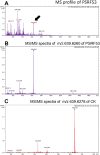Endophytic fungi of Panax sokpayensis produce bioactive ginsenoside Compound K in flask fermentation
- PMID: 38654024
- PMCID: PMC11039684
- DOI: 10.1038/s41598-024-56441-3
Endophytic fungi of Panax sokpayensis produce bioactive ginsenoside Compound K in flask fermentation
Abstract
Endophytes of Panax have the potential to produce their host plant secondary metabolites, ginsenosides. Panax sokpayensis, an endemic traditional medicinal plant of the Sikkim Himalayas was explored for the isolation of endophytic fungi. In the present study, we have isolated 35 endophytic fungal cultures from the rhizome of P. sokpayensis and screened for ginsenosides production by HPLC by comparing the peak retention time with that of standard ginsenosides. The HPLC analysis revealed that out of 35 isolates, the mycelial extracts of four fungal endophytes (PSRF52, PSRF53, PSRF49 and PSRF58) exhibited peaks with a similar retention time of the standard ginsenoside, Compound K (CK). LC-ESI-MS/MS analysis led to the confirmation of ginsenoside CK production by the four fungal endophytes which showed a compound with m/z 639.6278, similar to that of standard ginsenoside CK with yield in potato dextrose broth flask fermentation ranging from 0.0019 to 0.0386 mg/g of mycelial mass in dry weight basis. The four prospective fungal endophyte isolates were identified as Thermothielavioides terrestris PSRF52, Aspergillus sp. PSRF49, Rutstroemiaceae sp. strain PSRF53, and Phaeosphaeriaceae sp. strain PSRF58 based on ITS sequencing. The present finding highlights the need for further study on growth optimization and other culture parameters to exploit the endophytes as an alternative source for ginsenoside CK production.
Keywords: Panax sokpayensis; Compound K; Endophytes; Fungi; Ginsenoside.
© 2024. The Author(s).
Conflict of interest statement
The authors declare no competing interests.
Figures





Similar articles
-
Major ginsenoside contents in rhizomes of Panax sokpayensis and Panax bipinnatifidus.Nat Prod Res. 2018 Jan;32(2):234-238. doi: 10.1080/14786419.2017.1343322. Epub 2017 Jun 26. Nat Prod Res. 2018. PMID: 28649854
-
Antimicrobial activity of saponins produced by two novel endophytic fungi from Panax notoginseng.Nat Prod Res. 2017 Nov;31(22):2700-2703. doi: 10.1080/14786419.2017.1292265. Epub 2017 Feb 16. Nat Prod Res. 2017. PMID: 28278662
-
Potential participants and regulatory factors in ginsenoside biosynthesis of Panax ginseng C.A. Meyer: The role of endophytic fungus PBF-08.Plant Sci. 2025 Sep;358:112553. doi: 10.1016/j.plantsci.2025.112553. Epub 2025 May 10. Plant Sci. 2025. PMID: 40355047
-
Fungal endophytes as prolific source of phytochemicals and other bioactive natural products: A review.Microb Pathog. 2015 May;82:50-9. doi: 10.1016/j.micpath.2015.04.001. Epub 2015 Apr 9. Microb Pathog. 2015. PMID: 25865953 Review.
-
Endophytic fungi isolated from medicinal plants: future prospects of bioactive natural products from Tabebuia/Handroanthus endophytes.Appl Microbiol Biotechnol. 2018 Nov;102(21):9105-9119. doi: 10.1007/s00253-018-9344-3. Epub 2018 Sep 10. Appl Microbiol Biotechnol. 2018. PMID: 30203146 Review.
Cited by
-
Novel endophytic actinomycetes species Streptomyces panacea of Panax sokpayensis produce antimicrobial compounds against multidrug resistant Staphylococcus aureus.Sci Rep. 2025 Jun 5;15(1):19863. doi: 10.1038/s41598-025-05333-1. Sci Rep. 2025. PMID: 40473773 Free PMC article.
-
Nematicidal and Insecticidal Compounds from the Laurel Forest Endophytic Fungus Phyllosticta sp.Molecules. 2024 Sep 26;29(19):4568. doi: 10.3390/molecules29194568. Molecules. 2024. PMID: 39407499 Free PMC article.
References
-
- Tang W, Eisenbrand G. Chinese Drugs of Plant Origin. Springer; 1992. Panax ginseng CA Mey; pp. 711–737.
-
- Uchendu EE, Paliyath G, Brown DCW, Saxena PK. In vitro propagation of North American ginseng (Panax quinquefolius L.) In Vitro Cell. Dev. Biol. Plant. 2011;47:710–718. doi: 10.1007/s11627-011-9379-y. - DOI
Publication types
MeSH terms
Substances
Grants and funding
LinkOut - more resources
Full Text Sources
Research Materials

